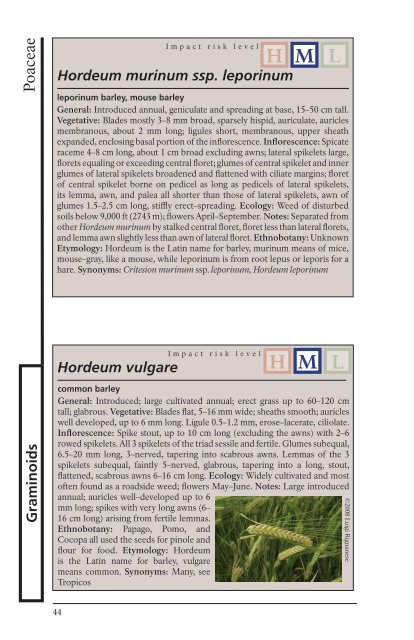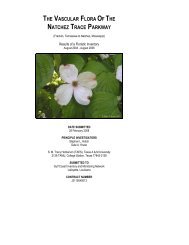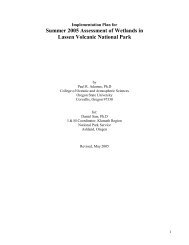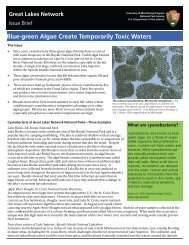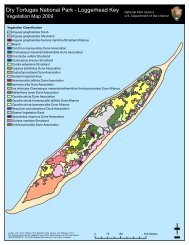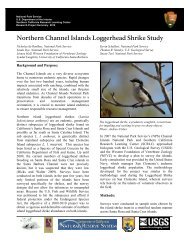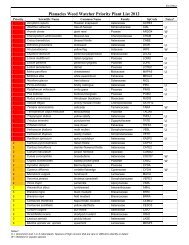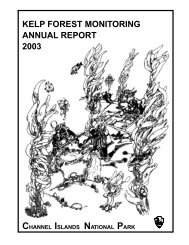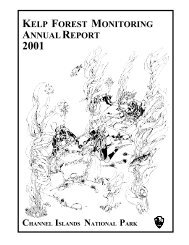Plants of Casa Grande Ruins National Monument - NPS Inventory ...
Plants of Casa Grande Ruins National Monument - NPS Inventory ...
Plants of Casa Grande Ruins National Monument - NPS Inventory ...
Create successful ePaper yourself
Turn your PDF publications into a flip-book with our unique Google optimized e-Paper software.
Poaceae<br />
Graminoids<br />
44<br />
Hordeum vulgare<br />
Impact risk level<br />
Hordeum murinum ssp. leporinum<br />
Impact risk level<br />
H M L<br />
leporinum barley, mouse barley<br />
General: Introduced annual, geniculate and spreading at base, 15–50 cm tall.<br />
Vegetative: Blades mostly 3–8 mm broad, sparsely hispid, auriculate, auricles<br />
membranous, about 2 mm long; ligules short, membranous, upper sheath<br />
expanded, enclosing basal portion <strong>of</strong> the inflorescence. Inflorescence: Spicate<br />
raceme 4–8 cm long, about 1 cm broad excluding awns; lateral spikelets large,<br />
florets equaling or exceeding central floret; glumes <strong>of</strong> central spikelet and inner<br />
glumes <strong>of</strong> lateral spikelets broadened and flattened with ciliate margins; floret<br />
<strong>of</strong> central spikelet borne on pedicel as long as pedicels <strong>of</strong> lateral spikelets,<br />
its lemma, awn, and palea all shorter than those <strong>of</strong> lateral spikelets, awn <strong>of</strong><br />
glumes 1.5–2.5 cm long, stiffly erect–spreading. Ecology: Weed <strong>of</strong> disturbed<br />
soils below 9,000 ft (2743 m); flowers April–September. Notes: Separated from<br />
other Hordeum murinum by stalked central floret, floret less than lateral florets,<br />
and lemma awn slightly less than awn <strong>of</strong> lateral floret. Ethnobotany: Unknown<br />
Etymology: Hordeum is the Latin name for barley, murinum means <strong>of</strong> mice,<br />
mouse–gray, like a mouse, while leporinum is from root lepus or leporis for a<br />
hare. Synonyms: Critesion murinum ssp. leporinum, Hordeum leporinum<br />
H M L<br />
common barley<br />
General: Introduced; large cultivated annual; erect grass up to 60–120 cm<br />
tall; glabrous. Vegetative: Blades flat, 5–16 mm wide; sheaths smooth; auricles<br />
well developed, up to 6 mm long. Ligule 0.5–1.2 mm, erose–lacerate, ciliolate.<br />
Inflorescence: Spike stout, up to 10 cm long (excluding the awns) with 2–6<br />
rowed spikelets. All 3 spikelets <strong>of</strong> the triad sessile and fertile. Glumes subequal,<br />
6.5–20 mm long, 3–nerved, tapering into scabrous awns. Lemmas <strong>of</strong> the 3<br />
spikelets subequal, faintly 5–nerved, glabrous, tapering into a long, stout,<br />
flattened, scabrous awns 6–16 cm long. Ecology: Widely cultivated and most<br />
<strong>of</strong>ten found as a roadside weed; flowers May–June. Notes: Large introduced<br />
annual; auricles well–developed up to 6<br />
mm long; spikes with very long awns (6–<br />
16 cm long) arising from fertile lemmas.<br />
Ethnobotany: Papago, Pomo, and<br />
Cocopa all used the seeds for pinole and<br />
flour for food. Etymology: Hordeum<br />
is the Latin name for barley, vulgare<br />
means common. Synonyms: Many, see<br />
Tropicos<br />
©2008 Luigi Rignanese


